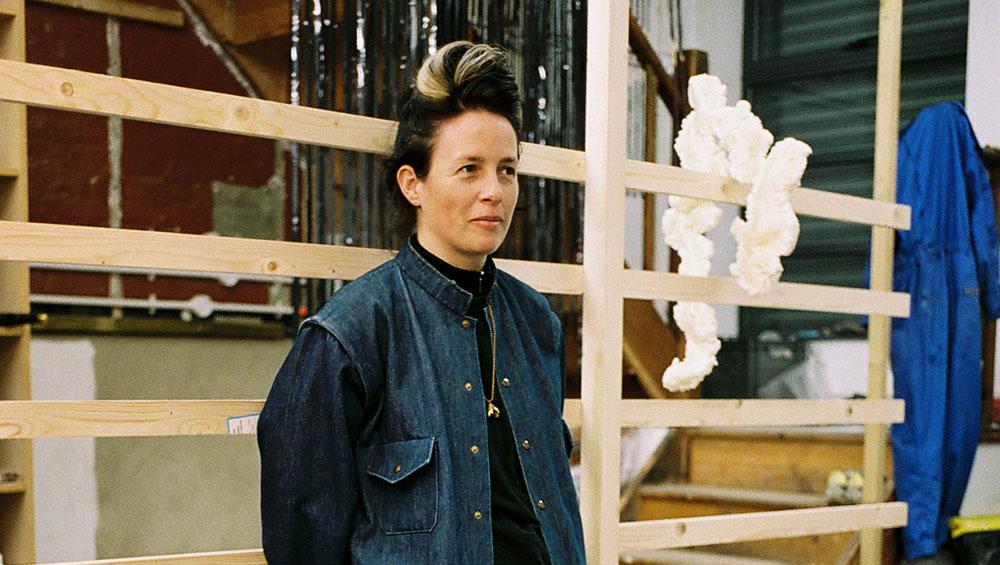
Anne Hardy. Photo: Erna Klewall. Courtesy the artist and Maureen Paley, London.
by DAVID TRIGG
Urban wild sites, in-between spaces and forgotten corners of London where discarded objects accumulate – these are the places that excite Anne Hardy (b1970, St Albans), whose large-scale sculptural works and photograms are composed from the residues, leftovers and sundry detritus she finds there. Her recent installations, which she calls FIELDworks, are immersive, sensory experiences that combine found objects with light, colour and sound.
Hardy invites us to enter her theatrical environments, which hover between reality and unreality, at once strange and familiar, abstract and representational. As we wander around them, soft carpet beneath our feet, we might see lumps of concrete, strips of metal, heaps of nitrous oxide canisters or suspended lengths of magnetic tape fluttering in an artificial breeze. Lights turn on and off and fans blow, while collaged soundtracks composed from field recordings and nonsensical words fill the air. These are sites where we become acutely aware of our own presence, encouraged to reimagine our present moment while considering potential futures.
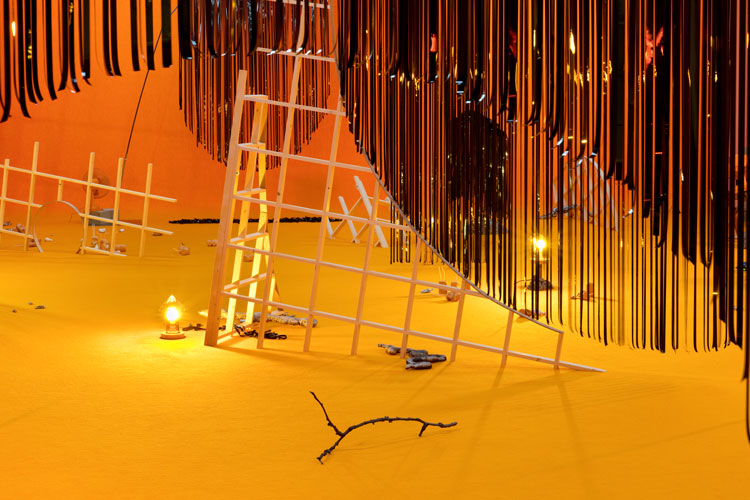
Anne Hardy. Liquid Landscape, 2018. FIELDwork – sculptural installation with audio, programmed light and wind. Exhibition view: Sensory Spaces #13, Museum Boijmans Van Beuningen, Rotterdam, 2018. Photo: Angus Mill. © Anne Hardy, courtesy Maureen Paley, London.
Though Hardy’s background is in painting, she made her name as a photographer in the 2000s. Her early images of surreal, sci-fi inflected interiors were meticulously constructed in the studio from hundreds of found objects. The dream-like sets were then destroyed, preserved only as large-scale photographs. For her 2015 exhibition at Modern Art Oxford, she produced a series of photograms – a darkroom technique in which objects are placed directly on to photosensitive paper and exposed to light. The resulting images invert the tonal values of lens-based photography; the greater the opacity of an object, the lighter its trace appears in the print. For these, Hardy used sweepings from her studio floor to create serendipitous, colour-saturated images that evoke fantastical landscapes, astronomical discoveries and microscopic worlds.
For Rising Heat, her exhibition at Maureen Paley’s new Studio M project space in Shoreditch, east London, Hardy has created a new series of photograms using objects gathered from the foreshore of the River Thames while she was working on her 2019 commission for Tate Britain, The Depth of Darkness, the Return of the Light, which transformed the gallery’s neoclassical facade into a marooned temple adorned with fairy lights, ripped banners and a cascade of detritus evoking the pollutants that choke waterways, rivers and oceans. The dystopian spectacle was accompanied by a 21-minute quadrophonic soundscape that used elements recorded on and around the Thames.
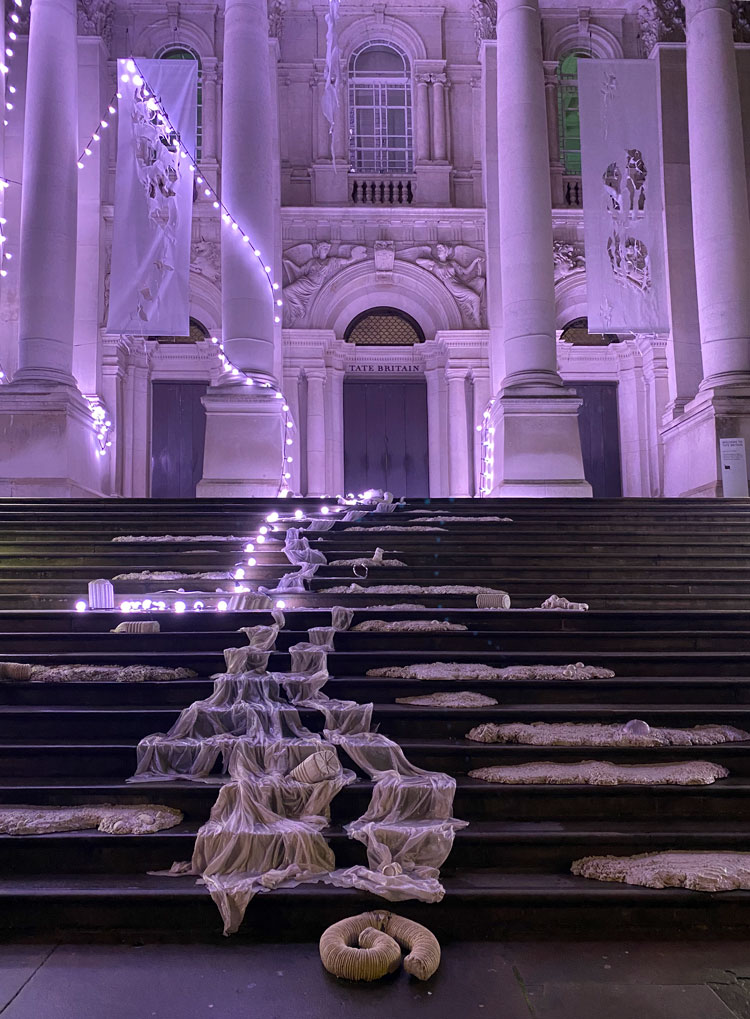
Anne Hardy. The Depth of Darkness, the Return of the Light, 2019. Tate Britain Winter Commission. FIELDwork - sculptural installation with quadraphonic surround sound audio and programmed light exhibition view: Tate Britain, London, 2019. Photo: Angus Mill. © Anne Hardy, courtesy Maureen Paley, London.
Studio International spoke to Hardy about these new photographic works, their relationship to her sculptural installations, how the pandemic has affected her work, and her plans for the future as society opens up.
David Trigg: You began making photograms in 2015, while you were working on Field, your solo show at Modern Art Oxford. Photography has long been a part of your practice, but what specifically drew you to photograms?
Anne Hardy: The process is liquid and speculative, which is akin to the kind of locations and thoughts I work from. I like the direct link that it gives me to materiality and to touch, while also allowing me to depict a space or an atmosphere that is not a literal image of something. Photograms allow me to work in a similar way to how I develop my installations, extracting and collecting elements from the real world – such as sound, objects and feelings – and using them to propose other realities and possibilities. The abstraction allows me to explore the sensibility and emotions of places or materials – how it feels to enter into the “wild space” between two motorways, for example, or to be among broken concrete fragments next to an inky black river, or pass through space by feeling rather than seeing.
DT: Your photograms are made using leftover material, found objects and other detritus. What informs your choice of waste?
AH: I’m interested in residues, leftovers, lost, found, and stranded things, as carriers of potential. I think of them like forgotten thoughts that might be important, that might be a key to a feeling or to the soul of the place that they are part of. My work is very much connected to specific types of locations within a city, places where I might find these things. I imagine the city as a kind of sea, with tides, and eddies and places where stuff gets stranded or deposited. I take things from those corners that are a bit like its unconscious.
DT: How do the photograms relate to your installations?
AH: I see my work as a thought process that coalesces in different ways: in Fieldwork installations, in photograms and so on, I am dealing with illusions, the creation of images, and proposed realities. Sometimes the photograms have a very direct relationship to an installation, as with the recent ones, which explore atmospheres and spaces in relation to my installation for Tate Britain, The Depth of Darkness, the Return of the Light, but they also exist as separate entities.
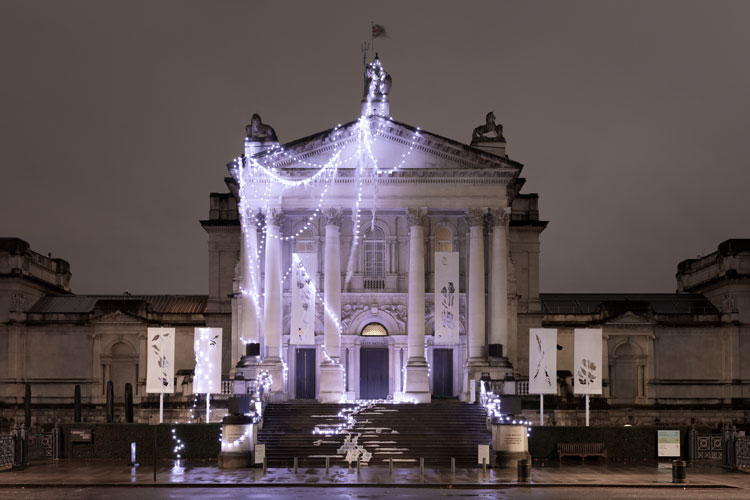
Anne Hardy. The Depth of Darkness, the Return of the Light, 2019. Tate Britain Winter Commission. FIELDwork - sculptural installation with quadraphonic surround sound audio and programmed light exhibition view: Tate Britain, London, 2019. Photo: Angus Mill. © Anne Hardy, courtesy Maureen Paley, London.
DT: How do you go about composing the images in the darkroom?
AH: It’s intuitive, experimental and highly controlled all mixed together. I try things, see what happens, and repeat. It is impossible to duplicate any outcome precisely, meaning that there is an exciting tension with every piece of paper I put through the developer.
DT: It seems like a very experimental process. Were there any images that you were not happy with?
AH: The ones I count as images are the successful ones, the rest are just a part of the process.
DT: You have spoken of your photograms in terms of flow and motion, describing them as gestures evoking processes of change. This reminded me of Stefan Themerson, an early pioneer of experimental photography, who used smoke, liquids and moving lights to produce his photograms.
AH: I want these recent photograms to carry a sense of transformation and change, as that’s what the original source material was about, a kind of instability of perception or knowledge, rather than a fixed moment.
.jpg)
Anne Hardy. Into Darkness (The Depth of Darkness, the Return of the Light), 2020. Unique photogram on c-type paper, 62.2 x 52 x 4 cm. © Anne Hardy, courtesy Maureen Paley, London.
DT: I’m interested in the role that colour plays in your work. Your installations often incorporate strong colours and these new photograms contain an array of hues. Conversely, the pioneers of the photogram – Man Ray, László Moholy-Nagy, Christian Schad et al – all produced black-and-white images.
AH: For me, colour is emotive, psychological, suggestive; it’s a material as much as any other that I work with. For example, at the 2017 Art Night festival, I chose a hue called “baby pink” for the carpet of my Fieldwork installation, Falling and Walking (phhhhhhhhhhh phossshhhhh crrhhhhzzz mn huaooogh). I wanted something entirely unconnected to the urban landscape spaces that the work drew its source material from, a colour that might evoke an altered state of some kind. In my new photograms, the colour is also a key to a state of mind, an atmosphere, a climate etc.
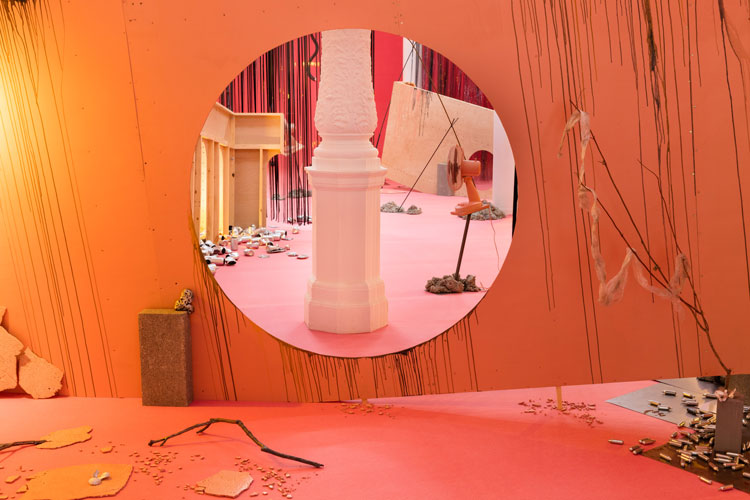
Anne Hardy. Falling and Walking (phhhhhhhhhhh phossshhhhh crrhhhhzzz mn huaooogh), 2017. FIELDwork - sculptural installation with audio, programmed light and wind. Co commissioned by Art Night and Contemporary Art Society exhibition view: Leeds Art Gallery, Leeds, 2018. © Anne Hardy, courtesy Maureen Paley, London.
DT: The images seem to hover at the intersection of representation and abstraction. Some evoke landscapes, others suggest astronomical imagery or microscopic views.
AH: I imagine the photograms as feelings or states; like remnants of touches and gestures at intimate or massive scales; like the variance between the touch of a breeze and a storm. I want them to suggest spaces where we become aware of our own presence, precisely because of the ambiguous or shifting scale between micro detail and infinite space. This state of hovering is about creating or finding a “gap” that sits between two states. For example, between representation and abstraction, or the known and unknown. If something is indeterminate, that brings potential. And potential brings agency for change, for involvement. That’s the energy I strive to bring into my recent installations. I want them to embrace you, but at the same time disrupt things and propose other realities. And that same line of thinking feeds into the photograms as well. I want them to provoke your imagination while making you aware of the contingency and mutability of perception.
.jpg)
Anne Hardy. Rising Heat (The Depth of Darkness, the Return of the Light), 2020. Unique photogram on c-type paper, 62.2 x 52 x 4 cm. © Anne Hardy, courtesy Maureen Paley, London.
DT: Titles seem to be another important element of your work. The ones you have used in the Rising Heat series, such as Into Darkness and Future Trace, suggest an underlying narrative.
AH: I spend a long time chasing my instincts through the thesaurus and dictionary to try to capture the right word or phrase that connects to a work; it needs to feel definite, but also ambiguous. It’s a strategy of suggestion and provocation, to pull you into the work and also give you tools to open up multiple readings. With the titles of these recent photograms, I was thinking about how states of weather, light, heat and so on can be used as narrative structures in literature, to guide you through the emotional and practical states of the protagonists, one of which might be the environment itself. For example, JG Ballard, in The Drowned World,uses the moment when heat rises as a time when some protagonists become dormant, and other things start to happen. The heat both calms and agitates. It creates the possibility for change. Something is stilled so that something else can come forward. I wanted the titles to be something you could connect to emotionally, as if it might happen to you – what will your Future Trace be, what would your Twilight Fever feel like? Where is the border between regular perception, dream state and hallucination?
.jpg)
Anne Hardy. Twilight Fever (The Depth of Darkness, the Return of the Light), 2020. Unique photogram on c-type paper, 62.2 x 52 x 4 cm. © Anne Hardy, courtesy Maureen Paley, London.
DT: Each photogram in the series has the same subtitle – The Depth of Darkness, The Return of the Light – which is also the title of the installation you created for Tate Britain in 2019. What is the relationship of these works to that project?
AH: The Depth of Darkness, the Return of the Light considered the Tate Britain facade as a kind of relic, a possessed site that could manifest its possible pasts and futures. I wanted to think about its fragility, strength, and other possible realities; what might this and other structures like it mean at a different time? Is what it stands for just a temporary illusion? The winter solstice (which the title is a description of) and the presence of the River Thames as a site of history and ritual became the way for me to connect into and manifest the idea of multiple timeframes, climates and atmospheres existing simultaneously. The sound element of the work drew on multiple references to the Thames, the potential of varying climates and aspects of its presence conveyed at different times. This was all in my head when I was working in the darkroom on the photograms. I was concentrating on what those atmospheres were, and how I could engage and manifest aspects of them in a different way. In the installation, the sound was what created the images. With the photograms, I’m using light and fragments of materials that are taken from the shore of the river in the course of my research and production process.
DT: You said of the Tate project that you hoped it might cause people to consider how fragile our existence is. It feels strangely prescient now, considering the extraordinary events of this past year. Your new exhibition was produced at the height of the pandemic. What impact has Covid-19 had on you and your work?
AH: For the last year, I’ve been working on more contained projects in my studio, on photograms, and building support networks with other artists. For now, my large-scale projects are on hold, though I hope most things will happen eventually. I’ve been thinking about the ground that I want to be able to stand on, what shape it will be in and what’s there with me.Art has the potential to change our perceptions, how we feel about the world and ourselves. I think that can be done in an emotional and instinctive way. This idea has played a big part in my thinking as I’ve developed works such as The Depth of Darkness, the Return of the Light, and Falling and Walking (phhhhhhhhhhh phossshhhhh crrhhhhzzz mn huaooogh). It is something that I really want to continue with once it becomes possible again.
.jpg)
Anne Hardy. Future Trace (The Depth of Darkness, the Return of the Light), 2020. Unique photogram on c-type paper, 62.2 x 52 x 4 cm. © Anne Hardy, courtesy Maureen Paley, London.
DT: Unlike traditional photography, where any number of prints can be made from a negative, each photogram is a unique physical object, a record of the photo paper’s contact with objects and light. Because of the current lockdown, you have chosen to exhibit these works online. How important is it that viewers eventually get to experience the works in person?
AH: Ideally, you would see these works in life, and that should hopefully happen in April. For the present time, it feels good to embrace the moment and show the work in the virtual way. I think it’s good to keep moving forwards and engaging with the world when the conditions are so uncertain. My installations absolutely require your physical presence within them, but I think images can work well on screen, too – you can be drawn into them as whole worlds.
DT: What are you most looking forward to when we finally emerge from this period of lockdowns and restrictions?
AH: I’m looking forward to being with people and “IRL” art again, to exchange and mix energies! One of the last artists I engaged with was Ann Veronica Janssens at South London Gallery. On the opening day, I was alone in the gallery with her work Untitled (Blue Glitter) (2015) and the experience was electric. To be physically present with someone else’s ideas and energy cannot be replicated in another way.
DT: Later this year, you will be artist in residence at the Chinati Foundation in Marfa, Texas, which was founded by Donald Judd. The desert site is located in a sparsely populated part of far west Texas, a very different context to the urban environments that normally inspire your work. What attracted you to this place?
AH: I’m excited about the desert. I’ve wanted to go to Chinati for some time to experience the spaces and situations that Judd made for his works. My recent installations are connected very much to landscape and the many layers that make it – the intersections between a landscape of the mind, physical space and perceptions. Judd saw the space around his work to be integral to it and wanted to create this very precise environment as a kind of grounding for his work. Although my work is very different, I feel an affinity with his approach. My installation works choreograph space, material, sound and light; they are tuned to affect you in specific ways. So I’m curious to see how spending time with Judd’s large-scale installations, as well as the rest of the collection, might be a productive way to think about my own practice.
DT: How will you approach the residency?
AH: My plan is to use the residency time to experiment with working with minimal means: field recordings, materials that are immediately to hand, and light – investigating the idea of the desert as a metaphor for an alternate reality where perception can shift and change, and testing how much I need in order to create a potentially transformative experience with my work. I am curious to see what I will discover.
• Anne Hardy: Rising Heat is available to view online until 28 March 2021. The exhibition will open to the public at Studio M, London, once the lockdown restrictions are eased.